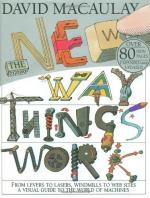
|
| Name: _________________________ | Period: ___________________ |
This test consists of 15 multiple choice questions and 5 short answer questions.
Multiple Choice Questions
1. What is a substance that contains only one type of atom?
(a) An element.
(b) A quantum.
(c) A cell.
(d) A molecule.
2. What is any engine that burns fuel inside the engine?
(a) Thermodynamic engine.
(b) Nuclear fusion engine.
(c) Steam engine.
(d) Internal combustion engine.
3. What is suction referred to in the act of flying?
(a) Lift.
(b) Floating.
(c) Sinking.
(d) Glide.
4. Upon what principle does a pulley work?
(a) The amount of work required is halved by the amount of effort.
(b) It is easier to overcome gravity than force.
(c) The rotation of one gear pulls the other.
(d) It is easier to pull something down rather than up.
5. What does one have to understand in order to understand the way things work?
(a) The terms of physics.
(b) The underlying principle.
(c) The reason something is made.
(d) The function of something.
6. What happens if the edges of the two wheels touch?
(a) The rotation of one will cause the other to rotate.
(b) Nothing unless they have cams.
(c) The one will stop the other wheel.
(d) The one wheel will wear out faster than the other.
7. What controls direction on a ship?
(a) A rudder.
(b) A valve.
(c) A drive.
(d) A screw.
8. Through what can heat not travel?
(a) Very dense elements.
(b) Very porous elements.
(c) There is nothing through which heat cannot travel.
(d) A vacuum.
9. What is the effort you put in combined with the distance over which the effort is done?
(a) Work.
(b) Mendal's law.
(c) Gravity.
(d) Rest.
10. What debris does a nuclear explosion create?
(a) Fallout.
(b) Steam.
(c) None.
(d) Acid rain.
11. What does the Mechanics of Movement explore?
(a) How the movement of anything can be either a net gain or net loss of energy.
(b) How pulleys can create energy.
(c) How the conservation of energy plays into movement, force, and effort.
(d) How pulleys ultimately lose energy that can never be regained.
12. What is one component of a lever?
(a) A spring.
(b) A straight edge.
(c) A caliper.
(d) A screw.
13. What is the result of a collision of molecules which break on impact forming new and different molecules?
(a) Fusion.
(b) Radiation.
(c) Combustion.
(d) Fission.
14. What is the density of salt water compared to fresh water?
(a) Salt water is denser.
(b) It depends on their electrical charge.
(c) Fresh water is denser.
(d) They have the same density.
15. What is convection?
(a) Heat moving from a liquid or gas molecule to another.
(b) When heat causes wind.
(c) When heat increases velocity.
(d) The way a molecule radiates heat.
Short Answer Questions
1. What occurs when molecules begin vibrating in a solid, then speed up their vibration when heated?
2. What is one example the author uses of a wedge?
3. In how many elements did the Greek believe?
4. What happens when an object is placed in water?
5. What is the factor which determines an object's ability to float?
|
This section contains 494 words (approx. 2 pages at 300 words per page) |

|




